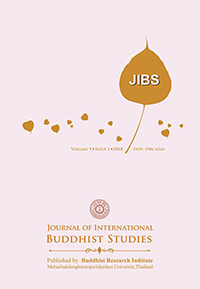The Mon Ordination Tradition and its Practices
Keywords:
Mon ordination, tradition, and practiceAbstract
The intention of this study is to describe the three types of ordination ceremonies in Mon State and their practices: (1) A splendid Mon ordination ceremony; (2) a simple Mon ordination ceremony; (3) an emergency Mon ordination ceremony; and (4) the practices of these Mon ordination traditions. A splendid ordination ceremony is a ceremony that is mixed with entertainment, many decorations, and an abundance of donations. A simple Mon ordination ceremony is held with few cultural celebrations and those that celebrate adhere only to the requirements of the Vinaya as given by the Buddha. An emergency Mon ordination ceremony occurs in the event of a serious illness of a beloved one or, alternatively, during a funeral ceremony. The practices of a Mon ordination ceremony is most commonly practiced in the form of a splendid ordination ceremony that the Mon people perform in an attempt to represent the occasion of the Bodhisatta Siddhattha Gotama’s renunciation and associated legendary events. It is a beautiful tradition and embodies meritorious deeds which will be illustrated with the Mon traditional ways of life, stories and the stories from the Buddha’s time.
In summary, this article will show the attitude of the Mon people towards the celebration of an ordination tradition which some could accuse of involving extraneous work and unnecessary additions. However, the Mon takes it as a moral and religious expression of their Buddhist way of life and feels there are many good reasons behind those celebrations.
References
Ashin Nyanna Vamsa, (2001). Literature and religious belief of the Mon people: University of Buddhist Pariyatti, Yangon. P, 284.
Bhattanta Nai Kalayāna, (1976). Book on the benefit of the Buddhist Sāsanā: The handy book for Bikkhu: Pha Out New Monastery. Mon State. P, 38.
Bhaddanta Uttamālańkāra, (2013). Dhammānuggahadī- panī, Showing the result of sponsoring Ordination of Novice, and Monk: Do Sar- sanar monastery. Kaloa village, North Ral Township, Mon State. P, 37-55.
Dha Nute Koko Zaw, (2013).U Shin Kyi, The way of worshiping and re- specting and its benefit: Shwe Naing Ngaing Press Yangon. P, 4-22.
Emmanuel Guillon, (1999).The Mon, A civilization of Southeast Asia: Printed Rangon 1969, Paris 1987, Bangkok 1994, Bangkok 1999. P, Introduction.
Thānissaro Bhikkhu, (2013).The Buddhist Monastic Code II, The Khand- haka Rules: Printed for free distribution 2001,Third edition revise 2013. Chapter 24, P, 4.
Ed. Fausboll, (1990). Jātaka: (J. I)Volume 1, ISBN 106 8.
Ed. f. l. Woodward, (1977). Udāna Commentary: (UdA) Translated. ISBN 1866. Published by Pali Text Society.
Nai Maung Toe, (1989).The Mon Tradition and The Mon Custom: Kon Chan Press, Yangon. P, 85- 89.
Nai Ba Maung who is 85 years old man from Kwan Hlar who knows very well about the Mon history and the Mon tradition, interviewed on 16th december, 2014.
Pālita,The head monk, (2014). The Mon History-Research Paper(1): Ka- marwor village, Mon State. P, 23.
Pālita, (2010). The History of the Mon Buddhism in all Ramannyadesa:
Printed for free distribution, Kamarwak VillageMon Myanmar. P, 87.
Peter Vredeveld, Hair of the Buddha: Rielerweg 71-73, 7416 ZB Deventer. Netherlands, Retrieved http://www.buddha-heads.com/buddha- head-statues/hair-of-the-buddha/.
Ramanya Nimala Bikhu, (2009). A book for monk: Printed Raja (Kwan Hlar Village), Mon Myanmar. P, 54
The Committee of Mon Literature and Culture, (1977). The Mon Tradi- tion: Yangon.
The Mon literature and Buddhist culture in all Mon state association, (2006).The Mon Tradition. Mon State. P, 39.







